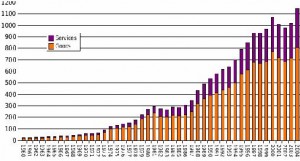The sub prime lending crisis in the real estate sector In the USA where in borrowers with a low or sub prime credit rating were given loans to invest in the booming real estate sector in 2004-05 has led not only to a dig slow down of the US economy but its effect was also felt over the major nations of the world.
In this project it has been tried in the best way possible to analyze the various ways in which the sub prime lending muddle actually started.It has also been tried to analyze the way the US banking and lending agencies camouflaged their sub prime loans In to attractive ones and how backed by some credit rating agencies, were able to sell them off to other banks and investors by dividing them into collateralize debt obligations (CDOs).
 This “A Study on Subprime Crisis and Its Effects on India MBA Project” also tries to give a comprehensive picture of the losses that the US banking sector incurred and not just that but how the whole sub prime muddle effected and questioned the banking practices in the world.
This “A Study on Subprime Crisis and Its Effects on India MBA Project” also tries to give a comprehensive picture of the losses that the US banking sector incurred and not just that but how the whole sub prime muddle effected and questioned the banking practices in the world.
In the end it has been tired to take an Indian view of the whole sub prime fiasco and how India, though effected by this, thankfully not in a big way, can actually avoid such a scenario from occurring in the country and all the measures and practices that can been taken into consideration to avoid such a scenario.
Objectives of the Study:
• To understand the meaning of “Sub prime Crisis”.
• To analyze the effects of Sub prime Crisis on the world.
• To analyze the impact of Sub prime crisis on India.
• To understand the risks and causes of Sub prime crisis.
Scope of the Study:
The study is to cover the impact of the sub prime crisis that started in United States of America which led to huge loss in its economy. The study also concentrates on impact of sub prime crisis on Global economics in general and Indian economy in particular.
Limitations:
• The study is very much limited to understand the reasons behind the crisis at origin and its impact on Indian economy.
• Due to the short period of time it was not possible to gather all the data.
• Since the crisis is quite recent there is no published manual available
Sub-prime loans are those given to borrowers whose creditworthiness is below prime and hence are of low quality. In India, sub-prime lending refers to loans carrying rates below the prime lending rate normally offered to high quality borrowers.
Sub-prime or low quality loans are mainly of three kinds: car loans, credit card loans and house mortgage loans. Of these, the biggest and the ones that can endanger the entire financial system are the house mortgage loans. These formed nearly one fifth of all U.S. mortgage loans in 2006, going up from 9 per cent till 2004.
The sub-prime loans were given to borrowers who did not have the capacity to service them (pay interest and repay principal). At the height of such lending, it was said, the borrowers were in the NINJA (no income, no jobs also) category. To lure such borrowers, some lenders adopted ‘predatory’ practices. They lent deliberately knowing that there will be default and, when it occurred, seized the houses mortgaged and sold them off to make a profit.
The basic question is why any lender (apart from the predatory ones) would give loans that carried the highest risk. One reason is that these carried higher interest rates. But, the main reasons seem to be two: large surplus funds with banks and the introduction of esoteric financial instruments that passed on the risk to unsuspecting investors.
Download A Study on Subprime Crisis and Its Effects on India MBA Project.
